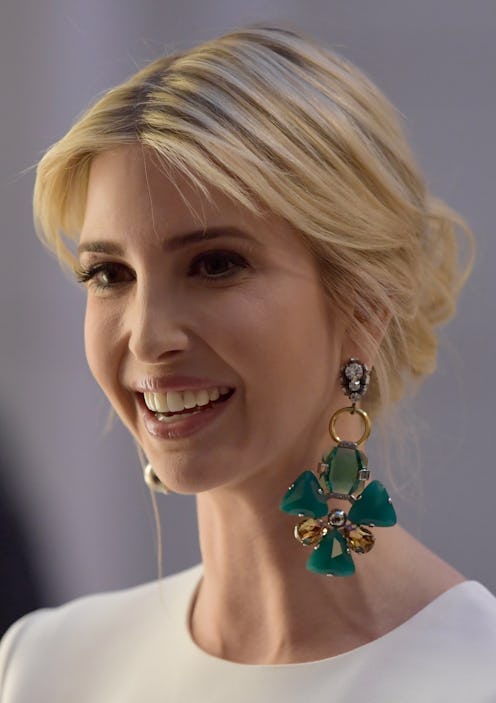News
Dear Ivanka, Poor Women Can't Afford To Have Planned Parenthood Cut Abortions From Its General Care

According to a profile of Ivanka Trump in The New York Times published Monday, the first daughter tried using the art of the deal when it came to Planned Parenthood and government support. According to the New York Times, Trump spoke to Cecile Richards, president of Planned Parenthood, and relayed a restructuring of sorts: "Planned Parenthood should split in two, Ms. Trump suggested, with a smaller arm to provide abortions and a larger one devoted to women's health services."
Richards reportedly rejected the idea. But it's not hard to understand where it came from. Planned Parenthood has come into the crosshairs of the Republican party for its abortion services — the American Health Care Act, still somehow working its way through Congress after a very public defeat in March, includes a provision preventing facilities like Planned Parenthood from receiving Medicaid reimbursements.
One of the main defenses of the organization is often pointing out that beyond the abortions that pro-lifers reject, Planned Parenthood provides numerous other services like birth control, prenatal care, and sexually transmitted disease and infection prevention that are far less controversial. In fact, according to Planned Parenthood, only 3 percent of its services are abortions.
If you're Ivanka Trump — new to policy-making but representing a brand for women — separating the easier parts of Planned Parenthood from the abortions seems like a simple solution.
But according to those who work in the field of reproductive health, separating abortion from the rest of Planned Parenthood's functions isn't just a bad solution — it could make providing those other forms of healthcare even harder.
"Abortion and family planning are primary care services, period," says Wayne Shields, president and CEO of the Association of Reproductive Health Professionals. "They're integral to health care for everyone and any attempt to segregate them shows a misunderstanding about how health care works."
She points to how often women coming into clinics like the Lovering Center for one kind of care — like STI care, or dealing with what seems like another problem with their reproductive system — only to discover they are pregnant, leading some to seek abortions.
Moreover, Trump's proposal ignores a critical and, to supporters of Planned Parenthood, frustrating detail about federal funds. "Let's be clear: Since federal funds already do not pay for abortions, any proposal that Planned Parenthood must 'split' into separate providers is about creating barriers to the full range of reproductive health care," Dawn Laguens, Executive Vice President of Planned Parenthood Federation of America, tells Bustle in a statement. "Women deserve the full range of reproductive care and information they need to make their own decisions."
According to Dr. Joyce Cappiello, a nurse practitioner at the Joan G Lovering Health Center in Greenland, New Hampshire, and a member of ARHP's board, separating abortion from other reproductive health services can be bad for patients who seek those services. She points to how often women coming into clinics like the Lovering Center for one kind of care — like STI care, or dealing with what seems like another problem with their reproductive system — only to discover they are pregnant, leading some to seek abortions.
"If there was quite a barrier between those services, that might make it very difficult for that woman to then get that service," she tells Bustle. Thus, she says, "it creates a logistical nightmare and makes it very difficult to access good care."
Cappiello speaks of having worked both at facilities that provide abortions and those that don't, and finding that the health professionals were far more able to provide care at facilities that included abortion services, without having to refer patients to other services. "When we make a referral, there's often a gap there, so people just don't get to that next step," she says.
Cutting off funding to facilities like Planned Parenthood that are focused on comprehensive family planning services could have wide-ranging effects on reproductive care overall.
"Asking Planned Parenthood to abandon our patients in need of safe abortion care in order to preserve our ability to provide cancer screenings and birth control is not a 'common-sense' idea. It is exactly what anti-women's health activists have been pushing for years as part of their goal to outlaw abortion entirely."
According to a November 2016 study by the Guttmacher Institute, facilities devoted specifically to reproductive care had better health outcomes for those cases than primary care providers that happened to include reproductive care. (The study did not examine differences between reproductive care facilities that included abortions and those that did not.)
Another 2016 study from the Guttmacher Institute found that 75 percent of abortion patients are considered poor (less than 100 percent of the poverty level) and low income (100 to 199 percent of the poverty level), meaning that help from non-profits like Planned Parenthood can be the difference in a woman's ability to seek an abortion when they need one. And for pro-choice advocates who fight for that ability, the request that they give up in offering abortions to the women who need them is an insult to their reproductive health mission.
"Asking Planned Parenthood to abandon our patients in need of safe abortion care in order to preserve our ability to provide cancer screenings and birth control is not a 'common-sense' idea. It is exactly what anti-women's health activists have been pushing for years as part of their goal to outlaw abortion entirely," says Laguens. "It is completely naive to believe they will stop at just separating services."